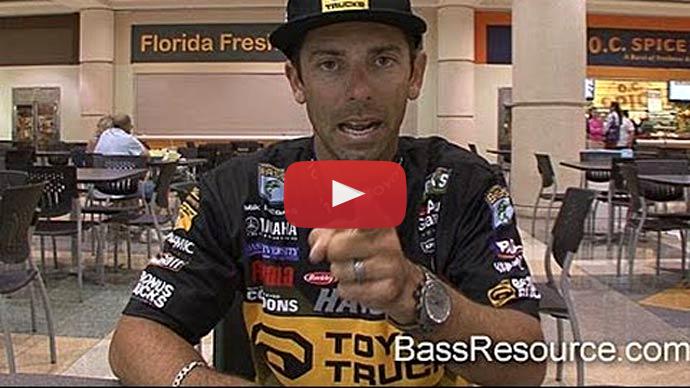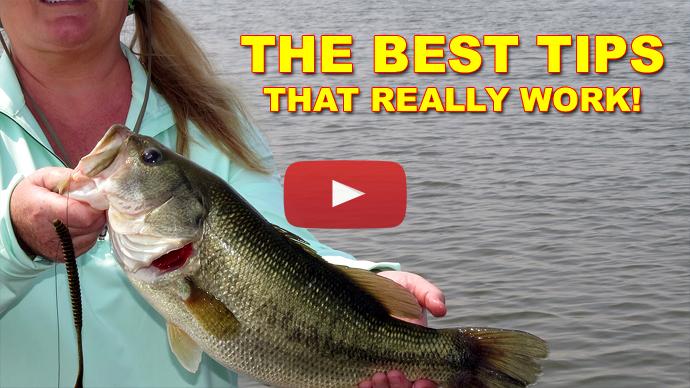A: The difference in line with Dropshot is pretty big. On an Elite Tour... and it's different. You know, I fish five a few times. Or, no, four. I'm sorry. I fish five a lot. Four pound I fish occasionally, in rare situations. And mainly why I did that in the past is because it was really tough, and it was, like, kind of late post-spawn, and there was a bunch of small fry, and that's all they're eating. They were smallmouth, and they're eating tiny stuff, like a half inch long. Those yellow perch fry.
And it happens like that. I've seen it in California more than anywhere, when they get balls of frys. And the only reason I did that in an Elite tournament is because they were just so hard to catch on a normal rig. You had to downsize to inch and a half long bait. And I could catch them on five pound, but it just seemed kind of heavy, and I couldn't get the weight. I had to go to a tiny weight, and I could only throw a five pound with a tiny bait, literally here to that boat. I couldn't get any distance in it.
And the fish were kind of just coming right up and boiling. They were in five to 10 feet of water, and it was real clear. And I broke some four pound out the next day, and it was a Oneida. And I got the four pound out, and spooled it up on their rod, and I put the same rig on. I could get 10 more feet out of it, at least. It felt better.
So it's just the way, basically, it presents the bait. It's not because I'm afraid of them seeing the line. I'm more trying to present the bait to them more naturally. And when they're eating bait that size, they get real funny.
But that kind of goes with all the six, seven, and eight pound. It's just presenting the bait more naturally. Like I said, I'm not afraid of the fish seeing it. I don't think they see the line. It's more the heavier the line you have, the more that that bait's connected to the line and your rod. It's kind of more direct. So you get, like on eight pound compared to six pound, there's a huge difference.
And there's so many reasons why I do that. I'm trying to think of them all. Six pound, like in deep water, if I'm fishing 70, 80 feet, which I don't do anymore. I just don't. They don’t have those kind of lakes back east. Now, I do it in shallow water, like 30, 40 feet. But I can get a smaller bait to the bottom quicker.
I use almost all Robo worms, but I also use the shad-shaped worms a lot, and live shads, Robo live shads. Those small baits. And it just, to me, using seven or eight pound doesn't feel right. It just sinks slower. If you have to use an 1/8th ounce weight, it'll take 10, 15 seconds longer to get to the bottom on one pound heavier line, in 40, 50 feet of water. Something like that. It takes a lot longer. Because the seven pound's kind of wiry, but six pound and five pound are just so much different.
In the past, that's why I've done that. It's just presenting a small bait to the fish, a real natural, and basically trying to eliminate the line from the bait. Trying to let that bait be as natural...
Q: Are you using spinning while you're doing that?
A: Yeah, most of the time. Occasionally I'll throw a six on a baitcaster, but not as much as I used to.
Q: So when you say a huge difference between the two line size, the three line size...
A: Casting.
Q: ...tell me what you're talking about. Casting in a way that...
A: Presenting. The way the bait falls. The way the bait falls in the water. I used five in the Green Bay tournament last year, and I caught a bunch of four-pounders on it, and it was terrible. Because they were all four and a quarters, and fours, and they were just strong. They were done spawning. They were eating a lot, and they were just really strong.
But the six pound, I had six, seven, and five rigged up. And it just slicked off, flat calm, and something snapped in my head and said, "Pick the five pounder rod up." As soon as I did that, I started getting more bites. Just because it was so flat calm, and it just... it's something about the way it falls. Same size weight. It's a light weight. But it's just the way everything worked, when you pick up your slack and pull your bait. It's like your line disappears even more. It's more just the bait floating in the water. And that's what made me get those bites quicker. But that's why I do that.
Q: And you didn't have braided?
A: Mm-mm. Well, down on the base of my spool did. But I use almost all fluoro. The only time I use braid on a spinning rod is when I'm trying to throw really tiny bait, and a 10 pound braid, I throw. And when my kids go fishing, I especially put... if it doesn't have braid on it, I put braid on it.
In fact, I take my kids fishing, and my six-year-old, he can cast, like, 70 feet. And he doesn't fish that much. He's a little guy. And I can give him an eighth, or a three-sixteenths, or even a quarter-ounce shakey fish, and he can throw it like a pro on 10 pound braid and a spinning rod. And it gets bit, and he can feel everything better, and they can hook them better. I do that for my kids a lot.
I do that occasionally, like if I need to throw a small bait really far, I'll use 10 pound SX1 braid. And you can get almost... seems like twice the distance on 10 pound braid, as far as compared to seven pound fluorocarbon. You can get twice the distance.
And if you do a knot, 12 wraps on the 10 pound. Yeah.
Q: Can you talk a little bit about fact that...
A: When I use that light line. Like the one for five pound is... I can almost touch the handle with it. I mean, I probably could. I just haven't tried. But it's really kind of flimsy. But on the five pound, you need that, because it is awful thin. And you hook into the big one, if you have too much backbone, you'll snap them off.
So the lighter I go, the softer rod. And the three pound rod I use is a trout rod, so I can kind of still hook them, but I won't break them off. Because if I use my five pound rod on my three pound rod, I'll snap every one of them off.
But I usually kind of... most of my equipment is like that, where I can hook them as hard as I can and not pop them off. Like my 16 pound jig rod. I know that rod well enough, and I know if I go to the 6 1/2 power, seven foot, and do the same hook set, I'm probably going to snap a fish off here and there. But that rod I used, a seven two, perfect pitch rod. Like in 16, I know even 14, I'm borderline, but I can still hook them about as hard as I can. I don't have to worry about holding back.
And usually when I set the hook, I set the hook as hard as I can, just about. I'm not basically powering it, I'm just really fast. I get a snap on most baits.
And that kind of reminds me, on that hook, that I was saying that you can just reel set them. On another sets, most of the time I do that. I don't really... I kind of real into the fish, and kind of give him a nice pull. You don't want to snap it really fast. You don't want to give them a traditional Texas rig, like a pop. You'll hook more of them. You just can't pull on them. Get that point to kind of sit, and then you kind of a nudge, and a powerful nudge, and get them on.



